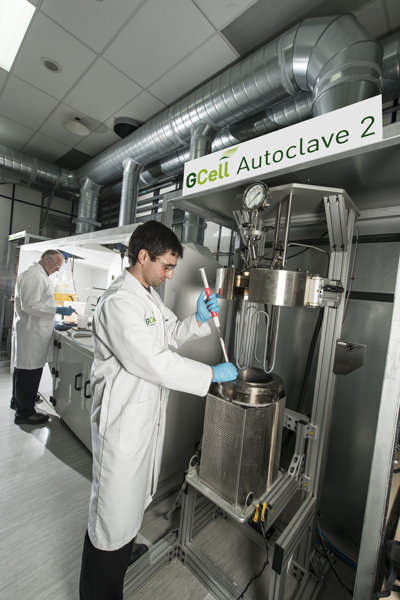G24 Power produces colloidal Titanium Dioxide (TiO2) nanoparticles with tunable particle size from 18 to 30nm with high anatase purity, variable light trapping characteristics with transparent or opaque coating options and formulations targeted to achieve tunable pore volume needed for emerging solid state solar cells based on Perovskite and other light absorbers.
Download our new TiO2 Product Datasheet
 The performance of Dye Sensitized Solar Cells depend on the surface area of mesoporous TiO2 film, surface states on TiO2 nanoparticles, dye coverage on the TiO2 surface and impregnation of electrolyte or solid state hole conducting materials inside the nanoporous film.
The performance of Dye Sensitized Solar Cells depend on the surface area of mesoporous TiO2 film, surface states on TiO2 nanoparticles, dye coverage on the TiO2 surface and impregnation of electrolyte or solid state hole conducting materials inside the nanoporous film.
Reducing the size of nanoparticles will increase the surface area, while reducing the pore size and pore volumes of the nanoporous film. Both dye sensitization and pore-filling of electrolyte or hole conductor inside the nanoporous films are adversely influenced by lower pore size and pore size distributions causing low performance and device instability.
This effect is even greater for bulkier sensitizing molecules and highly viscous electrolyte or organic and inorganic hole conducting materials. The following Table 1 (Courtesy: the data is adapted from Titania Particle Size Effect on the overall Performance of DSSC, T. P. Chou, et al, J. Physc. Chem. C, 2007, 111, 6296-6302) show the effect of TiO2 particle size on the performance of Dye Sensitized Solar Cells.
Table 1: Effect of TiO2 particle size on photovoltaic performance of DSSC tested under AM 1.5 conditions
| Particle Size (nm) | Voc (V) | Jsc (mA/cm2) | Fill Factor | Overall Conversion Efficiency |
|---|---|---|---|---|
| 9.8 | 0.730 | 3.59 | 0.535 | 1.40% |
| 10.7 | 0.710 | 3.75 | 0.560 | 1.49% |
| 15.3 | 0.710 | 6.39 | 0.570 | 2.59% |
| 18.9 | 0.720 | 10.60 | 0.557 | 4.25% |
| 22.5 | 0.730 | 12.20 | 0.583 | 5.19% |
Low filling of organic or inorganic hole conducting materials in dye sensitized TiO2 film is well documented in the literature [I. Ding, J. M-Kyriazi, N. Cevey-Ha, K. G. Chittibabu, S. Zakeerudein, M. Graetzel, M. McGehee, Organic Electronics, 11, 2017 (2010)]. Â Collaborative work carried out between EPFL and Konarka demonstrated direct correlation between hole-conductor filling, device performance and stability. Â Table 2 Shows the effect of TiO2 size on the relative performance of Solid State Dye Sensitized Solar Cells made by filling with spiro-MeO-TAD [small hole conductor molecule] and poly (3-hexylthiophene) [polymeric hole conductor].
Table 2: Effect of TiO2 particle size on photovoltaic performance of Solid State DSSC tested under AM 1.5 conditions
| Particle Size (nm) | Voc (V) | Jsc (mA/cm2) | Fill Factor | Overall Conversion Efficiency | Hole Conductor |
|---|---|---|---|---|---|
| 20 | 0.798 | 5.63 | 0.314 | 1.41% | Spiro-MeO-TAD |
| 30 | 0.799 | 5.74 | 0.589 | 2.71% | Spiro-MeO-TAD |
| 20 | 0.713 | 3.155 | 0.428 | 0.968% | Poly(3-hexylthiophene) |
| 60 | 0.802 | 3.901 | 0.504 | 1.575% | Poly(3-hexylthiophene) |
The life time of Solid State DSSC under continuous one sun irradiation conditions is greatly enhanced from less than 100 hours to over 1000 hours by increasing the TiO2 size from 20 nm to 30 nm. Supporting document is available upon request. Large pore sizes (25 to 30 nm pore diameter) are needed for efficient Cobalt electrolyte based cells as well as Perovskite based Solar Cells.
G24 Power can offer hydrothermal derived anatase TiO2 colloids with narrow particle size fractions in the range from 18 to 30 nm to suit various applications in Dye Sensitized and Perovskite Solar Cells, requiring precise performance tuning. Particles sizes less than 10 nm are also available for Cosmetic, Photocatalysis, and Piezoelectric Capacitor Applications.

